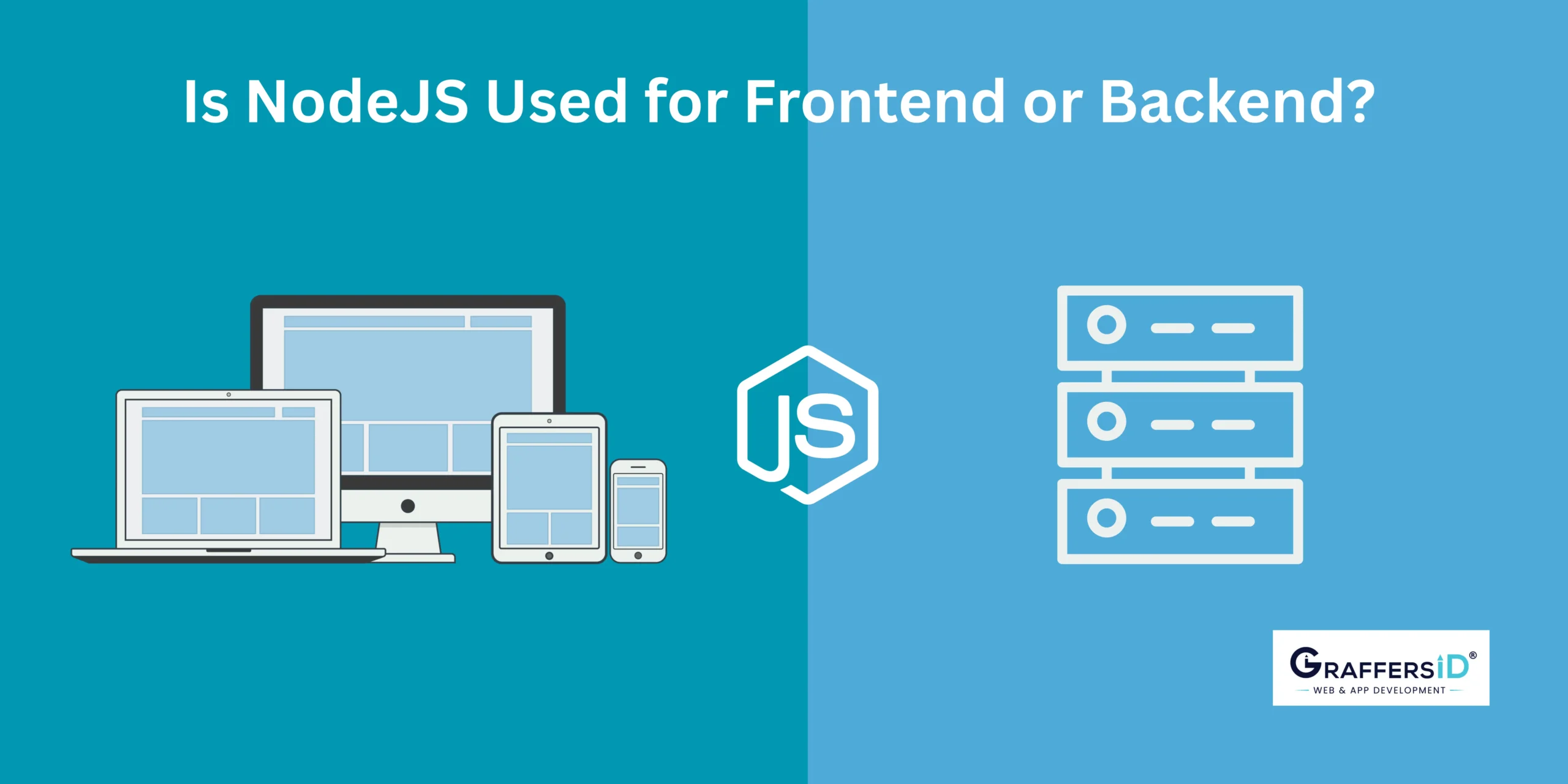In modern web development, Node.js has changed how developers build scalable, high-performance applications. Unlike traditional server-side technologies that depend on languages like PHP or Java, Node.js uses JavaScript, traditionally a front-end language, to power both client and server-side development. This unification enhances workflows and efficiency and simplifies full-stack development.
But is Node.js meant for front-end or back-end development? If you’re unsure, this full guide will clear up the confusion. We’ll discuss what Node.js is, its key applications, and how it smoothly integrates into both front-end and back-end development, making it the best choice for advanced web applications.
What Is Node.js and Its Purpose?

Node.js is an open-source, cross-platform JavaScript runtime environment that allows developers to execute JavaScript code outside a web browser. Built on Google Chrome’s V8 JavaScript engine, Node.js is designed for building scalable applications.
Initially introduced in 2009, Node.js revolutionized JavaScript by bringing it to the backend, which helped eliminate the need for multiple frameworks for client and server-side development.
Purpose of Node.js
- Server-Side Development: Enables JavaScript to run on the backend, making it possible to build server-side applications.
- Event-Driven, Non-Blocking I/O Model: This handles multiple requests efficiently without blocking execution.
- Full-Stack JavaScript Development: Allows developers to use JavaScript for both front-end and back-end, reducing the need for multiple programming languages.
- Microservices and API Development: These are commonly used for RESTful APIs and microservices architecture.
Key Features of Node.js
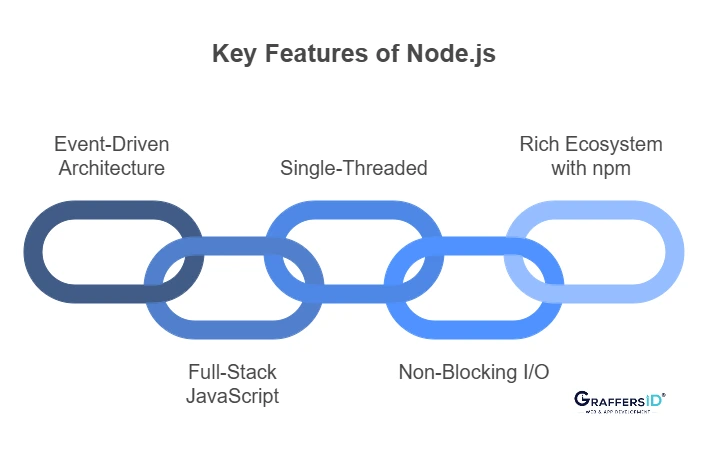
Node.js has become increasingly popular in recent years and has become the go-to choice for many companies due to its lightweight, fast performance, and scalability. Let’s take a look at some of the top features of Node.js that make it such an attractive option for web development:
1. Event-Driven Architecture:
Ensures non-blocking execution, allowing multiple tasks to run simultaneously without waiting for previous operations to complete. Ideal for real-time applications like chat apps, gaming, and live-streaming platforms.
2. Full-Stack JavaScript (Both Front-End and Back-End)
Enables smooth development with JavaScript for both client-side (React, Angular, Vue) and server-side (Express.js, NestJS). Reduces the need to switch between different programming languages, enhancing productivity.
3. Single-Threaded with High Scalability
Uses a single-threaded event loop model to handle multiple concurrent requests efficiently. Scales well for high-traffic applications like social media platforms and e-commerce websites.
4. Non-Blocking I/O Operations
Handles I/O operations (file system, databases, APIs) asynchronously, preventing server slowdowns. Increases responsiveness, making it perfect for data-intensive applications.
5. Rich Ecosystem with npm (Node Package Manager)
Provides access to millions of reusable packages and libraries to speed up development. Supports advanced tools like AI/ML integrations, GraphQL, and cloud services for enhanced functionality.
Why Is Node.js Important for Developers?
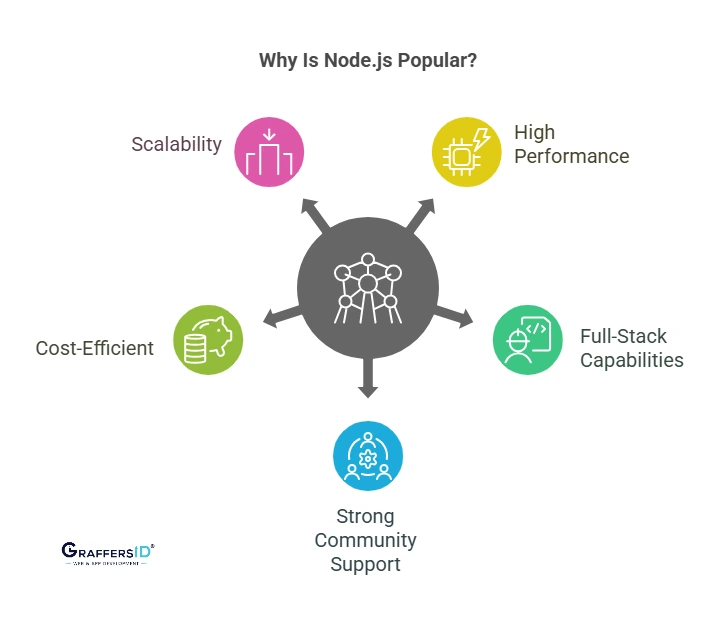
- High Performance: Because of its non-blocking I/O and V8 engine, Node.js can handle multiple operations concurrently, making it ideal for real-time applications.
- Full-Stack Capabilities: Developers can use the same language (JavaScript) for both front-end and back-end, reducing the learning curve and improving efficiency.
- Strong Community Support: Node.js has an extensive community of developers who contribute libraries, frameworks, and updates, ensuring continuous improvement.
- Cost-Efficient: By using JavaScript across the entire development stack, businesses save money on hiring specialized developers for different languages.
- Scalability: Node.js is widely used for applications requiring real-time updates, such as chat apps, stock trading platforms, and multiplayer gaming.
Read More: 11 Best NodeJS Frameworks For Web Apps
Use Cases of Node.js
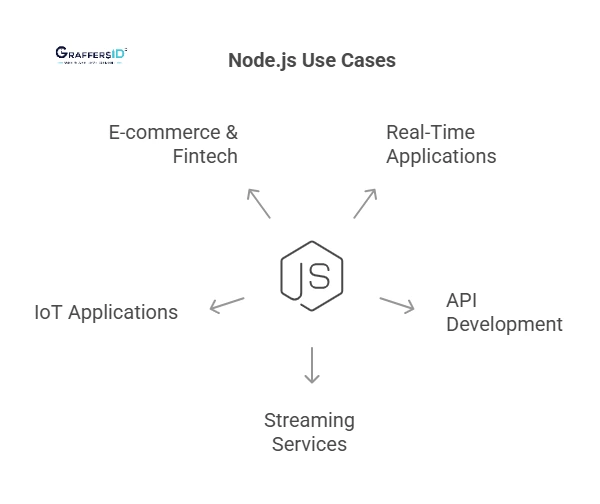
1. Real-Time Applications (Chat & Collaboration Tools)
-
Node.js is widely used for real-time applications like chat apps, live notifications, and collaborative tools (e.g., Google Docs, Slack).
-
It’s event-driven, non-blocking I/O ensures smooth real-time data exchange.
-
Example: Slack, Discord, Microsoft Teams
2. API Development (REST & GraphQL APIs)
-
Node.js is a top choice for building fast, scalable APIs using Express.js or NestJS.
-
Supports both RESTful and GraphQL APIs for modern applications.
-
Example: PayPal, LinkedIn, Netflix
3. Streaming Services & Media Applications
-
Its ability to handle large data streams makes it ideal for video & audio streaming.
-
Used by platforms offering on-demand content, video conferencing, and live streaming.
-
Example: Netflix, YouTube, Twitch
4. IoT Applications
-
Node.js is efficient in handling multiple concurrent device connections with minimal latency.
-
Ideal for smart home systems, industrial IoT, and wearable tech.
-
Example: Fitbit, Nest (Google), Tesla
5. E-commerce & Fintech Platforms
-
Node.js provides high performance and scalability for handling online transactions.
-
Used in e-commerce, banking, and fintech applications.
-
Example: Walmart, PayPal, Amazon
What is Front-End Development?
Front-end development refers to the user-facing part of a web application. It’s everything that users interact with directly in their web browser. This includes the design, layout, and interactivity of the website or application.
Key Technologies Used in Front-End Development:
- HTML: Defines the structure of web pages and provides the foundation for displaying content.
- CSS: Styles the web pages, making them visually appealing and responsive across different devices.
- JavaScript: Adds interactivity to web pages, enabling dynamic content and user engagement.
- Frameworks and Libraries: Technologies like React.js, Angular, and Vue.js provide tools for building complex front-end applications more efficiently.
What is Back-End Development?
Back-end development refers to the server-side components of an application that users do not see. It handles database interactions, authentication, server configurations, and business logic.
Key Technologies in Back-End Development:
- Database Management: Manages data storage and retrieval using databases like MongoDB, MySQL, and PostgreSQL.
- Server Management: Ensures that requests from users are processed correctly using frameworks like Express.js and Koa.js.
- Authentication & Authorization: Uses security mechanisms to control user access and protect data.
- API Development: Creates endpoints that enable the front-end to communicate with the back-end efficiently.
Back-end developers work on the logic that makes an application function behind the scenes, ensuring data flow and user requests are handled efficiently.
How Do Front-End and Back-End Work Together?
- The front end interacts with users and sends requests to the back end.
- The back end processes these requests, retrieves or updates data, and sends responses back.
- APIs (Application Programming Interfaces) facilitate smooth communication between both ends.
Example: When a user submits a form on the front-end, the back-end handles the request, processes it (e.g., storing data in a database), and sends a response back to the front-end to update the UI accordingly.
Node.js for Frontend Development
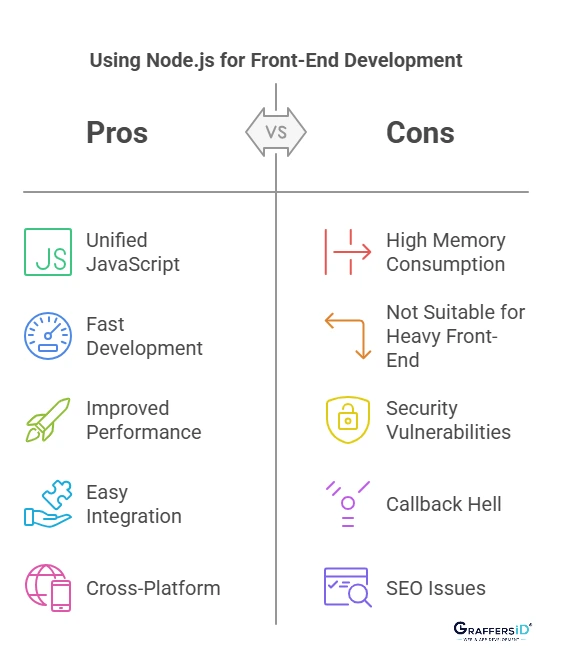
Pros of Using Node.js for Front-End Development
1. Unified JavaScript
Since Node.js allows JavaScript to be used for both front-end and back-end, developers can work within a single programming language across the entire application. This eliminates the need to learn multiple technologies, making full-stack development faster and more efficient.
2. Fast Development
Node.js provides a rich ecosystem of npm (Node Package Manager) modules, which include popular front-end development tools like Webpack, Gulp/Grunt, and Parcel.js. These tools streamline front-end workflows, making development quicker and more productive.
3. Improved Performance
Node.js operates on an event-driven, non-blocking I/O model, which speeds up front-end development tools and package management processes. This leads to faster build times and reduces the overall computational load on the system.
4. Easy Integration with Front-End Frameworks
Node.js smoothly integrates with front-end frameworks like React.js, Vue.js, and Angular. Many of these frameworks rely on Node.js for:
-
Server-Side Rendering (SSR) to improve SEO and initial page load time (e.g., Next.js for React).
-
Static Site Generation (SSG) to deliver pre-built pages for better performance.
5. Cross-Platform Development
Using frameworks like Electron.js, developers can build desktop applications using web technologies (JavaScript, HTML, and CSS). This enables cross-platform app development, reducing the need for separate codebases for macOS, Windows, and Linux.
Cons of Using Node.js for Front-End Development
1. High Memory Consumption for Large Applications
Node.js can be memory-intensive, especially when used for handling large UI frameworks and bundlers. Developers need to optimize code and manage dependencies efficiently to prevent performance issues.
2. Not Suitable for Heavy Front-End Computations
Node.js is single-threaded, which means it struggles with CPU-intensive front-end tasks like complex animations, image processing, or large-scale data visualization. WebAssembly (WASM) or Web Workers are often needed to offload heavy computations.
3. Security Issues in npm Packages
The npm registry contains thousands of third-party packages, but not all are actively maintained or secure. There is a risk of malware-infected packages or outdated libraries resulting in issues with front-end applications.
4. Callback Hell in Asynchronous Code
Many Node.js-based front-end tools rely on asynchronous programming. If not managed properly, developers can face callback hell, where nested callbacks make the code hard to read and maintain. Using Promises or async/await can help, but it requires proper implementation.
5. SEO Issues with Client-Side Rendering (CSR)
Many Node.js front-end frameworks, like React and Vue, use Client-Side Rendering (CSR) by default. CSR can lead to SEO issues since search engines struggle to index content that is loaded dynamically. Server-side rendering (SSR) with Next.js is often needed for better SEO, adding extra complexity.
Node.js for Backend Development
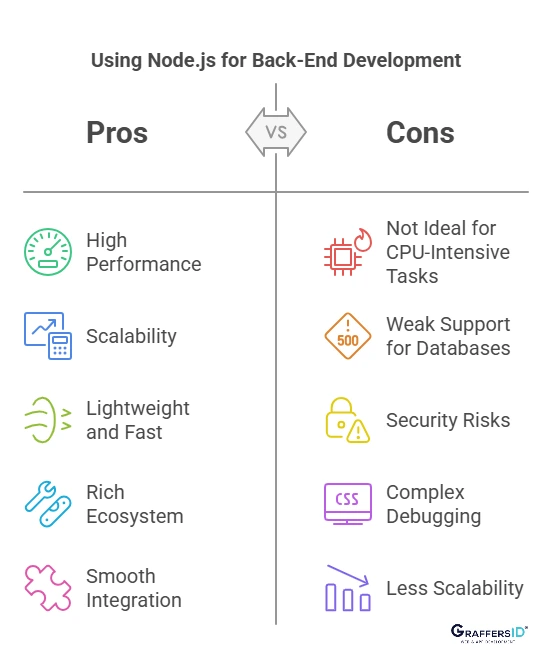
Pros of Using Node.js for Back-End Development
1. High Performance
Node.js uses an event-driven, non-blocking architecture, making it highly efficient for handling multiple concurrent requests. Ideal for real-time applications like chat apps, live streaming, and gaming platforms.
2. Scalability
Node.js is well-suited for microservices-based applications, allowing developers to scale different parts of the system independently. This makes it an excellent choice for enterprise applications and large-scale software projects.
3. Lightweight and Fast API Development
With frameworks like Express.js, Nest.js, and Fastify, developers can quickly build RESTful APIs and GraphQL backends. Node.js is widely used for creating lightweight, fast backend services that can handle high traffic loads efficiently.
4. Rich Ecosystem
The npm ecosystem provides a wide range of backend-focused libraries for authentication, database management, caching, and logging. Popular backend-related npm packages include MongoDB, Sequelize, and JWT.
5. Smooth Integration with Front-End Technologies
Since both front-end and back-end can be built using JavaScript, Node.js allows faster development cycles and easier debugging. This results in a more unified development experience for full-stack projects.
Cons of Using Node.js for Back-End Development
1. Not Ideal for CPU-Intensive Tasks
Node.js is single-threaded, which means it struggles with tasks that require heavy CPU processing, such as Machine Learning (ML) algorithms, image, and video processing. For such use cases, multi-threaded languages like Python, Java, or Go are better alternatives.
2. Weak Support for Relational Databases
Node.js works best with NoSQL databases like MongoDB, Firebase, and CouchDB. However, it is not as optimized for relational databases like MySQL or PostgreSQL, where ORMs like Sequelize can be complex to manage.
3. Security Risks with Asynchronous Code Execution
Asynchronous execution can lead to security issues like injection attacks and data leaks due to poor handling of asynchronous processes. Developers must use proper validation, authentication (OAuth, JWT), and input sanitization to ensure security.
4. Callback Hell and Complex Debugging
Managing multiple nested callbacks in large-scale backend applications can result in unreadable code. While using Promises, async/await, or event-driven programming can help, improper use can still lead to difficult debugging scenarios.
5. Less Scalable
While Node.js is scalable, it does not handle multi-core processing natively. To maximize performance, developers need to use:
-
Clustering (using PM2 process manager)
-
Load balancing (using Nginx, Kubernetes)
-
Microservices architecture adds complexity to the application design.
Node.js for Front-End vs. Back-End: Which One Should You Choose?
Node.js is widely used in both front-end and back-end development, but its role and benefits differ in each domain. Understanding its applications in both areas can help you decide whether to use Node.js for front-end, back-end, or full-stack development.
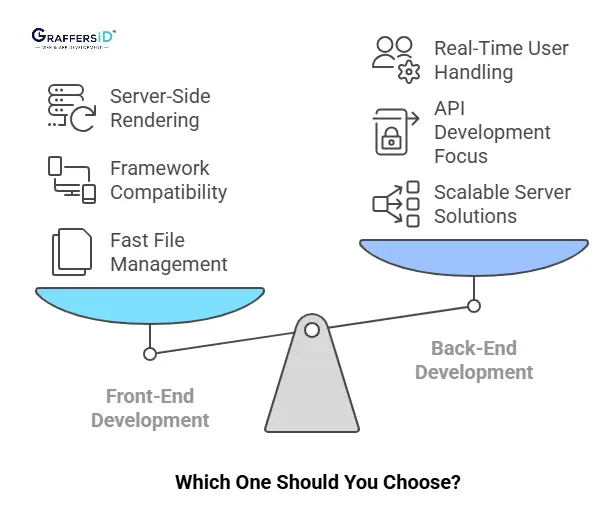
When to Use Node.js for Front-End?
Use Node.js for front-end development when you need a fast and efficient environment to manage and bundle files using tools like Webpack and Babel. It is essential for working with JavaScript frameworks like React, Vue, and Angular, enabling server-side rendering (SSR) for better SEO and performance.
When to Use Node.js for Back-End?
Use Node.js for back-end development when building APIs, real-time applications, and scalable server-side solutions. It is ideal for handling multiple simultaneous users, making it perfect for chat apps, live streaming, and online gaming.
Comparison: Node.js for Front-End vs. Back-End
| Feature | Node.js for Front-End | Node.js for Back-End |
| Primary Role | Development tools, SSR, dependency management | Server-side logic, API development |
| Key Frameworks | React.js, Vue.js, Angular, Electron.js | Express.js, Nest.js, Fastify, Koa |
| Performance Needs | Faster bundling and optimized rendering | High concurrency and I/O-heavy operations |
| Best Use Cases | Static site generation, UI frameworks, front-end tooling | Real-time apps, APIs, microservices, database operations |
| Not Ideal For | Direct UI rendering, complex animations | CPU-heavy tasks, complex SQL transactions |
Node.js for Full-Stack Development
Node.js plays a crucial role in full-stack development, enabling developers to build both front-end and back-end using JavaScript. The combination of Node.js for the back-end and frameworks like React or Angular for the front-end allows development.
Benefits of Node.js for Full-Stack Development
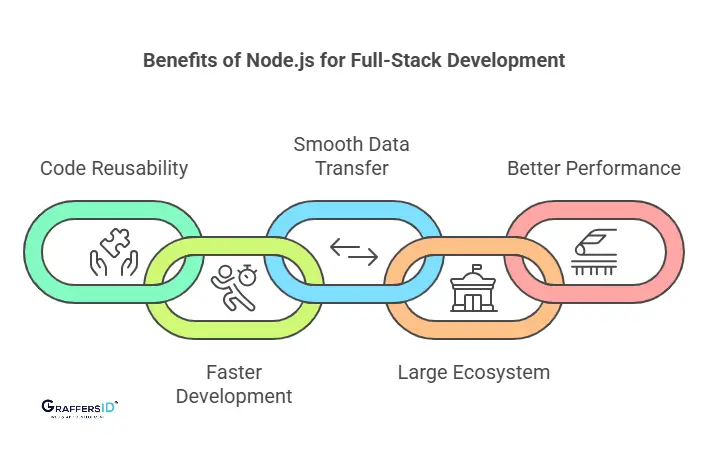
- Code Reusability: Developers can use the same codebase for both front-end and back-end, reducing redundancy and improving efficiency.
- Faster Development: With JavaScript running on both sides, there’s less context switching between different programming languages, leading to faster development.
- Smooth Data Transfer: JSON (JavaScript Object Notation) is natively supported in Node.js, making data exchange between client and server smooth and efficient.
- Large Ecosystem: The extensive npm (Node Package Manager) library provides various tools and frameworks, speeding up development.
- Better Performance: Node.js handles asynchronous operations efficiently, ensuring fast execution of web applications.
Read More: Top 10 Trusted Node.JS Development Companies
Common Node.js Challenges in 2025
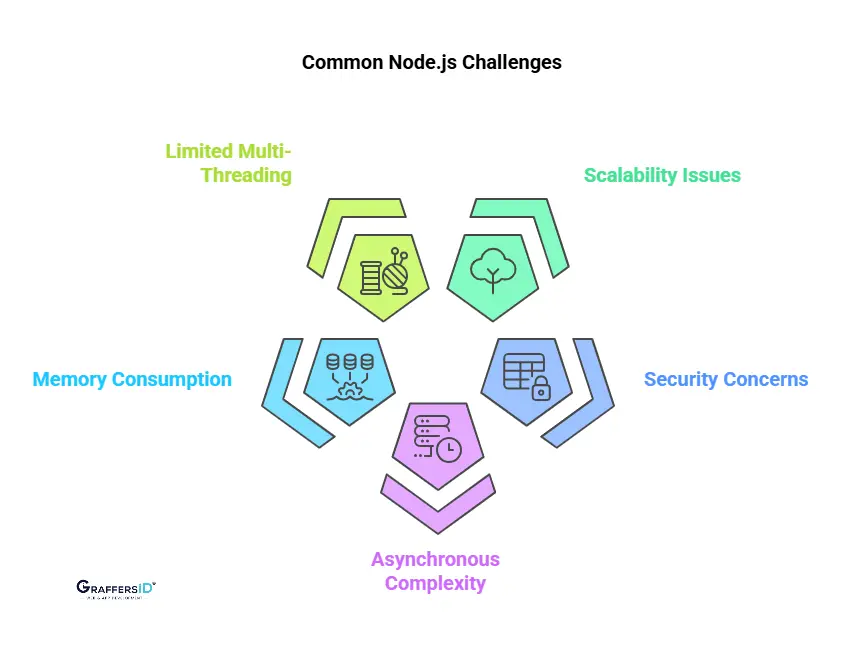
- Scalability Issues: Although Node.js is lightweight, handling large-scale applications requires careful architecture planning.
- Security Concerns: Due to its open-source nature, it is sensitive to security threats like dependency attacks.
- Asynchronous Complexity: While non-blocking I/O is a key feature, it can lead to callback hell if not managed properly.
- Memory Consumption: Poorly optimized Node.js applications can consume excessive memory, affecting performance.
- Limited Multi-Threading: Although Node.js is single-threaded, it may not be ideal for CPU-intensive applications.
Future Trends of Node.js
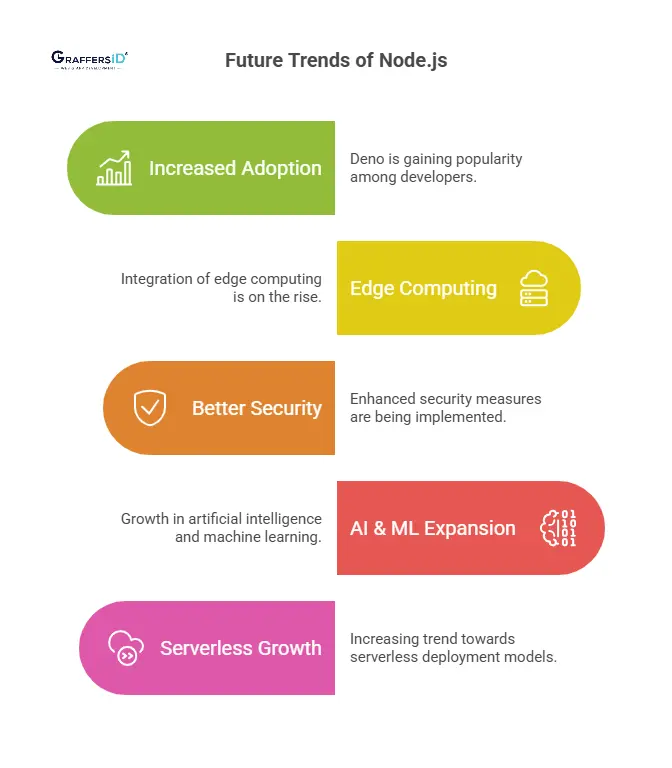
- Increased Adoption of Deno: Deno, a secure alternative to Node.js, is gaining traction and may influence the future of JavaScript runtime environments.
- Edge Computing Integration: With real-time applications becoming more prevalent, Node.js is expected to integrate more with edge computing to reduce latency.
- Better Security Measures: Developers are focusing on improved authentication, encryption, and secure coding practices to enhance security in Node.js applications.
- Expansion in AI & ML: Node.js is increasingly being used for artificial intelligence and machine learning applications, offering new possibilities for automation and analytics.
- Serverless Deployment Growth: More applications are adopting serverless architectures, where Node.js plays a crucial role due to its lightweight and event-driven nature.
Conclusion
Node.js is a powerful choice for full-stack development, offering high performance, scalability, and an active community. With its growing ecosystem and active community, Node.js continues to offer new opportunities for developers to build modern, scalable web applications.
Looking to build high-performance, scalable applications with Node.js?
At GraffersID, we offer expert remote Node.js developers who specialize in creating robust back-end systems, real-time applications, and full-stack solutions.
Get in touch with GraffersID today to hire dedicated Node.js developers and take your project to the next level!
